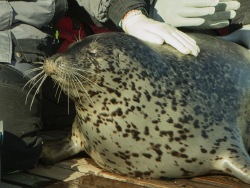Spotted seal gets back to the Primorsky Aquarium after a long journey

After an absence of half a year, one of the Primorsky Aquarium’s six spotted seals — Dulcinea, or Dusya for short — has returned home! Her journey lasted from May to late November. As this period coincides with the seals’ seasonal migration, Igor Katin, who is Scientific Head at the Laboratory of Marine Mammals, the A. V. Zhirmunsky National Scientific Center of Marine Biology, FEB RAS and Principal Specialist at the Primorsky Aquarium Shared Equipment Facility, thinks that Dusya, together with a major portion of the spotted seals from Peter the Great Bay, travelled a long way.
“We cannot, of course, prove it but I am sure that it was a seasonal migration that Dulcinea undertook,” said Igor Katin. “During a warm season most of the seals inhabiting the bay move either northward, reaching the Amur Liman, or southward, to Pusan; only 20% of this population, at best, stay in the bay, and right now migrants are coming back to spend winter in their birthplace. Perhaps, Dusya is a migratory individual, and nature has taken its course. My theory about migration can be supported by the fact that our spotted seals sometimes went on short journeys but they usually got back in a few days while Dusya was away for six months.”
Dulcinea returned early in the morning. She recognized all members of her big “family” – both her companions and people that had worked with her. Unlike the humans, the other seals took her arrival in stride; Dusya immediately joined in the training session, looking as if she had never left. These six spotted seals are the Aquarium’s research “staff members”: they participate in programs studying sensory systems in marine mammals. Due to her absence, Dusya has fallen behind in her training a bit but now she is making up for lost time.
“I was asked an absolutely stupid question if I was sure that the seal was Dusya. How can you fail to recognize your own child? Each seal is unique, and I can always recognize mine,” Igor Katin continued. “We held an investigation of her disappearance. By now we know that instinct drove her to migrate but then we got really scared by the fact that she was not around. In Ussury Bay there were a lot of fishing gears, and I was very afraid that she might have perished. Within the first month I spent every day waiting for her to come back. I explored all the nearby bays by boat, in the marine reserve (translator’s note - the Far Eastern Marine Biosphere State Nature Reserve) I checked all the groups of seals: each of them seemed to be Dusya. I gradually resigned myself to her absence. Primarily, I was anxious not about her having abandoned us – if she decided to strike out on her own, we would not mind it – but about her possible death, and that was the hardest part.”
Now Dulcinea is feeling fine, she has no health problems except for weight. The first weighing after her reappearance showed that it was only 67 kilos, while last December Dusya weighed 97 kilos. In summer, spotted seals actively forage to put on weight to successfully overwinter; for instance, when on migration, they gather at salmon rivers with easily available food. For some reason, Dusya was unable to gain sufficient weight. The spotted seals at the Primorsky Aquarium are kept in natural surroundings, and the “traveller” has to build up the needed fat layer before hard frosts occur that is why she is being provided with a high-calorie diet.
“Interestingly, Dusya did not merely return to the place she had left,” stressed Igor Katin. “When she was away, the animal enclosure complex of the shared equipment facility “migrated” too – it was relocated to another bay – and the spotted seal came back to the place from where she had been absent for more than two years. There is a theory of biological signal field explaining how animals that travel long distances recognize specific locations and return there. It is still unclear if this process engages sensory systems or other mechanisms unknown to us but the fact remains, and Dusya’s case confirms it – she could find her home. This fact pleases us also because she had a choice – the entire Pacific Ocean was at her disposal but she got back to us.”